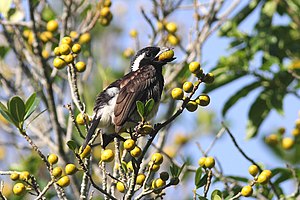White-eared bearded bird
| White-eared bearded bird | ||||||||||||
|---|---|---|---|---|---|---|---|---|---|---|---|---|

White-eared bearded bird feeding |
||||||||||||
| Systematics | ||||||||||||
|
||||||||||||
| Scientific name | ||||||||||||
| Stactolaema leucotis | ||||||||||||
| ( Sundevall , 1850) |
The white-eared bearded bird ( Stactolaema leucotis ) is a species of bird in the African bearded family. The species occurs in East Africa. Several subspecies are distinguished. The IUCN classifies the white-eared bearded bird as not endangered.
Appearance
The males of the nominate form reach a wing length of 8.8 to 9.4 centimeters. The beak length is 1.8 to 2.0 centimeters. The tail is between 5.0 and 5.4 inches long. Females have similar body measurements. There is no noticeable sexual dimorphism . Individuals of this species weigh between 48 and 61 grams.
Males and females are black-brown from the forehead to the nape of the neck, the feathers of the forehead to the central part have shiny black, lanceolate tips. A white stripe runs over the eye, which widens slightly at the end and runs above the ear covers and along the front sides of the neck. The sides of the head, the throat and the chin are black, the feathers each have hair-like tips. The upper side of the body is black and has a brownish wash from the middle of the back to the upper tail-ceiling. The feathers on the rump sides and the upper tail coverts either have white feather tips or are lined with white. The control springs are black-brown, on the underside they are a little more matt. The underside of the body is white from the chest to the under tail coverts. The rear flanks are also white. The front chest and the sides of the body to the flanks are brown to black. The beak is black. The featherless skin around the eyes is gray, the eyes are brown. The feet and legs are black to gray-brown. Young birds are blacker than the adult birds. With them, the featherless skin around the eyes is still flesh-colored.
It can be confused with the mirror-bearded bird , which however has a yellow stripe over the eyes.
Distribution area and habitat
The distribution area of the white-eared bearded bird extends from the Mount Kenya massif over the southeast of Kenya and the plateaus of Tanzania, the south of Malawi, the east of Zimbabwe via Swaziland to the east of the South African Republic. Directly on the coast it occurs only in the south of Mozambique and in the South African province of Natal . Regionally you can find it at altitudes of 2600 meters.
The white-eared bearded bird is a regionally common bird that predominantly inhabits moist forests in the highlands. The habitat must have large trees with dead branches. The white-eared bearded bird uses these to create its nesting and resting holes. It occurs preferentially at forest edges and on clearings. He also uses gardens and secondary forest , where this is adjacent to primary forest .
Way of life
The food spectrum of the white-eared bearded bird consists to a very large extent of fruits. He eats figs , mangoes, guavas, papau and juniper berries. Insects are also taken in. These include moths, grasshoppers, wasps, hornets, cockroaches, and dragonflies. It also eats spiders.
White-eared bearded birds are social birds that are often associated with other African bearded birds. Opposite Olivbartvögeln , Diadem barbets and mountain barbets is the white ear Bartvogel the dominant species. It is also discovered the more attentive way that potential predators earlier and shouting warns.
White-eared bearded birds, like almost all bearded birds, are cave-breeders. The nest holes are chopped into dead wood, and young birds from previous broods are often involved. The nesting holes are five to 18 meters above the ground. You spend up to six weeks building the nest box. The small honey indicator and possibly also the black-throated honey indicator are breeding parasites of the white-eared bearded bird.
The breeding season begins towards the end of the main rainy season. The clutch consists of two to six eggs. The breeding season is 14 to 18 days. In addition to both parent birds, older young birds are also involved in the incubation. Switching between breeding birds occurs at intervals of 10 to 20 minutes. After hatching, parent birds and the older young birds are involved in feeding the nestlings. As a rule, food is brought to the nest cavity between eight and twenty times an hour. The nestling period is around 39 days. Both the parent birds and the helpers rest in the nest box during the night. It is not yet known whether young birds of both sexes stay close to the parent birds in the first year of life and help with the rearing of the next brood.
supporting documents
literature
- Lester L. Short, -Jennifer FM Horne: Toucans, Barbets and Honeyguides - Ramphastidae, Capitonidae and Indicatoridae . Oxford University Press, Oxford 2001, ISBN 0-19-854666-1
Individual evidence
Web links
- Stactolaema leucotis inthe IUCN 2013 Red List of Threatened Species . Listed by: BirdLife International, 2012. Retrieved September 5, 2013.